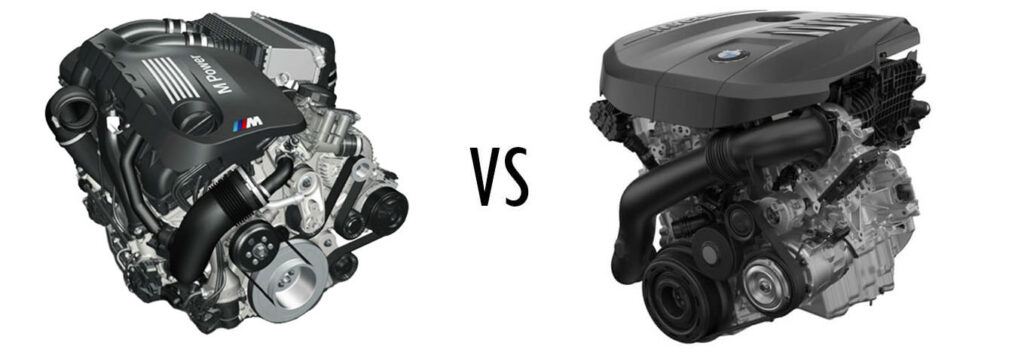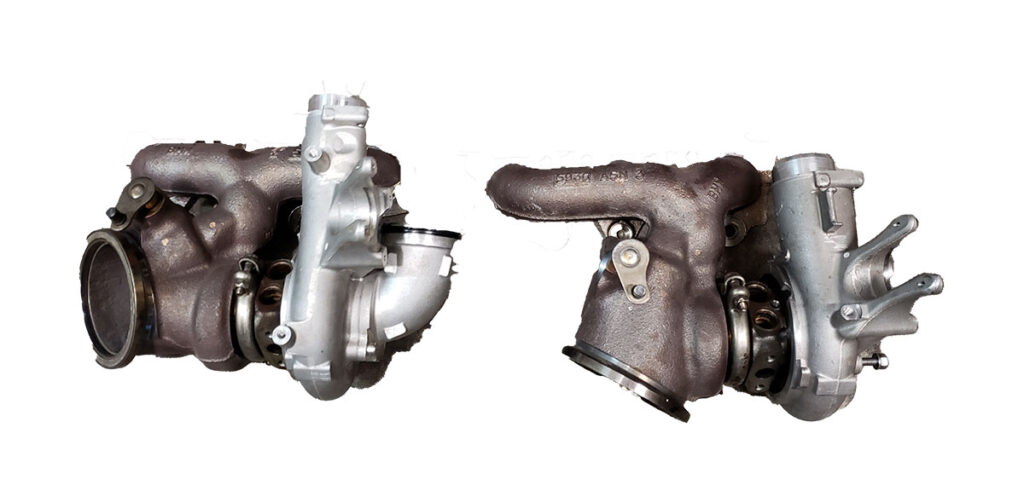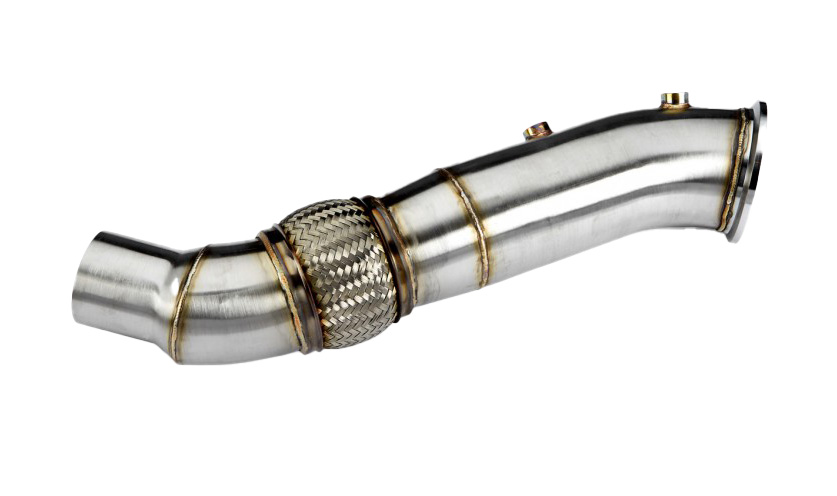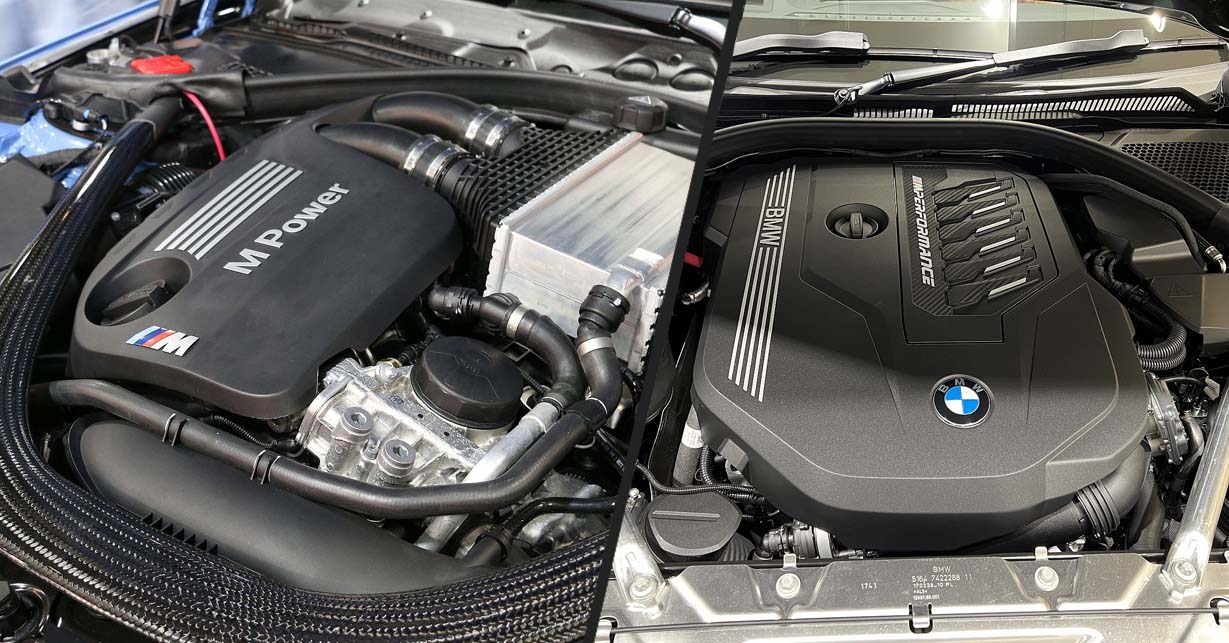BMW has been making impressive turbocharged inline-6 engines since the N54 was first introduced in 2006. The S55 and the B58 are some of the latest and most powerful iterations of this formula.
The S55 powers the F80 M3, F82 M4, and the M2 CS, and was introduced as a replacement for the naturally-aspirated V8 S65. It has been widely praised as a potent powerplant with immense tuning potential.
On the other hand, BMW designed the B58 as the direct successor of the N55, powering many vehicles ranging from the 2-Series M240i to the gargantuan X7 40i. Similarly, it has been regarded as a significant improvement over its predecessor in terms of power delivery, reliability, and tuning.
In this article, we will compare the BMW S55 to the BMW B58, exploring their specifications, performance, tuning potential, internals, and sound characteristics.
BMW S55 vs. B58 Specifications

| BMW S55 | BMW B58 | |
|---|---|---|
| Horsepower | 359 – 454 hp | 322 – 382 hp |
| Torque | 383 – 443 lb-ft | 332 – 369 lb-ft |
| Displacement | 2,979 cc | 2,998 cc |
| Turbocharger | Twin mono-scroll turbochargers | Single twin-scroll turbocharger |
| Compression Ratio | 10.2:1 | 11.0:1 |
| Internals | Forged crankshaft, forged connecting rods. | Forged crankshaft, forged connecting rods. |
| Fueling | Direct injection | Direct injection |
| Block design | Closed-deck block | Closed-deck block |
| Bore x Stroke | 84 mm x 89.6 mm | 82 mm x 94.6 mm |
| Redline | 7,600 RPM | 7,000 RPM |
S55 vs. B58 Horsepower & Torque
The BMW S55 has a higher horsepower & torque output from the factory; after all, it is a high-performance BMW M-division engine while the B58 is not. The B58 makes its peak horsepower of 382 hp between 5,000rpm and 6,500rpm while the peak 454 horsepower of the S55 extends from 5,000rpm all the way up to 7,300rpm.
S55 has more horsepower, more torque, and a wider powerband
The B58 produces a maximum torque of 369 lb-ft between 1,380rpm and 5,000rpm while the S55 outputs its maximum torque of 443 lb-ft between 1,850rpm and 5,500rpm. As such, the B58 thrives in the lower end of the RPM range while the S55 is more of a top-end screamer, exactly what you’d expect from an M engine.
The S55 can rev up to 7,600rpm. One of the ways BMW managed to achieve such a high redline with the S55 is due to “Mahle”-designed pistons with a special low friction coating. The B58 has a more pedestrian redline of 7,000 rpm.
Related: BMW M340i vs. F80 M3 Comparison
S55 vs. B58 Internals, Valvetrain & Cooling
In terms of internals and design, both the S55 and the B58 share several similarities. They both feature closed-deck aluminum blocks, with a forged crankshaft and forged connecting rods. Both engines also incorporate Valvetronic and VANOS for variable valve lift and variable valve timing, respectively.
Another similarity is both the S55 and the B58 use a top-mounted air-to-liquid intercooler. Both powerplants also utilize two water pumps: a main belt-driven coolant pump and an auxiliary electric pump that helps cool down the turbos after engine shutdown.
The S55 has stronger internals with a more robust cooling and oiling system
One notable difference is that the S55 has stronger pistons, and different valve springs to allow it to operate at higher RPMs. It also boasts a more robust cooling system with larger radiators.
The S55 doesn’t have a dry-sump oiling system, but additional covers in the oil pan restrict oil movement during high-G turns or hard acceleration to keep oil pressure high throughout the rotating assembly.
The B58 was designed with many improvements carried from the S55
On the other hand, the B58 is built on BMW’s new modular B engine architecture, bringing efficiency and power delivery improvements. One of the new features is an engine heat encapsulation system, which reduces startup wear and heat cycles. The B58 has more of an under-square design compared to the S55, with comparatively longer strokes; this is great for low-end torque.
On the B58TU, the exhaust manifold is integrated into the cylinder head housing for weight savings, while the S55 has an exhaust manifold integrated into the turbine housing of the turbocharger.
S55 vs. B58 Turbochargers: Twin turbo and single turbo.
One of the more obvious differences between these engines lies in their turbocharger setup. The S55 makes use of two single-scroll turbochargers whereas the B58 uses a single twin-scroll turbocharger setup. The twin-turbo setup of the S55 has advantages such as less turbo lag lag, more top-end power, and more consistent air compression.

The S55 has two single-scroll turbos, while the B58 has a single twin-scroll turbo
The B58’s single twin-scroll turbocharger is lighter and integrated into the exhaust manifold, contributing to weight savings. Each turbocharger in the S55 operates with three cylinders at a time and is equipped with electronically controlled wastegates.
A twin-scroll turbocharger is better than a single-scroll turbocharger because it gathers exhaust from multiple cylinders at a time. However, a twin-turbocharged setup is also able to alternate between pairs of cylinders while also pushing more power.
S55 vs. B58 Tuning & Mods
Both engines are highly tunable, but the B58 is more cost-effective to tune. You can add 30 whp and 30 wtq to both engines with a simple ECU tune. Heavily modded engines can reach 800-1000 horsepower, making them some of the best modern tuner engines available.
Parts for the S55 are usually more expensive and installation might be more labor-consuming than the equivalent part in the B58. For example, the S55 needs two catless downpipes while the B58 needs a single one.

Both engines are excellent for tuning, but mods for the B58 cost less
The most common BMW S55 mods include: new intake, catless downpipes, an upgraded top-down intercooler, E85 fueling, an ECU tune. To extract the most power possible out of the engine you’ll need to replace the turbos with bigger units, PureTurbos being a popular upgrade.
The B58 on the other hand has a power ceiling similar to the S55. The most common B58 mods include an ECU tune, performance intake, a catless or high-flow downpipe, upgraded fueling, an upgraded charge pipe, a new turbo inlet, meth injection. Similarly, if you want the best possible power gains you’ll need to upgrade the turbo to bigger one.
S55 vs. B58 Sound: which engine sounds best?
The S55 is a performance engine from the get-go, but it has never been perceived as a particularly great-sounding engine. Its exhaust sound is not the most pleasant thing to hear, as it lacks the richness and wow factor of the sound coming from other turbo straight-six engines.
The aggressive upshifts, downshifts, and burbles are loud but not considered particularly special or refined. The twin-turbo setup of the S55 can also contribute to the muffling of the exhaust sound.
The B58 has a much better exhaust sound than the S55.
Conversely, the B58 produces a cleaner and more pleasant exhaust note. The sounds coming out ot the B58 resembles its predecessor, the N55, which many consider the best-sounding inline-6 BMW engine.
The B58 sounds a bit cleaner and more refined while high RPM ranges sound “racier” than the S55. A nicely-tuned aftermarket exhaust can improve the sound of the S55 but a good exhaust for the B58 can make it sound amazing. All in all, both of these engines sound great, but the B58 sounds better.
S55 vs. B58 Reliability: is the B58 more reliable?
Both of these engines have proven to be very dependable with no major issues, but the B58 will typically cost less to own and maintain. The S55 is a high-performance engine from the get-go which means that it’ll typically need more labor for maintenance items and parts for it can get pricey.
The most common BMW S55 engine problems include oil leaks from the valve cover gasket, the oil pan gasket, the oil filter housing gasket, and potential hub crank issues. The most common BMW B58 engine problems include coolant loss, high oil consumption, rough idle, and leaks at very high mileage.
Both are very reliable engines; the B58 will have cheaper maintenance
Both the S55 and the B58 are more reliable than other BMW V8 turbo engines that offer similar power, like the N63TU. They are also more reliable than early turbo inline-6 engines such as the N54.
If you take proper care of these with frequent oil changes and don’t abuse them while they are cold, they should stay trouble-free for hundreds of thousands of miles. Even so, the B58 is a bit easier to live with since it’s not expensive to keep running.
Conclusion: Is the B58 better than the S55?
The S55 is a much more exciting and capable engine from the factory which is why you can find one in track-ready cars such as the BMW M3, BMW M4, and the M2 CS.
It is a clear high-performance engine with an angry character, with a clear emphasis on performance and top-end power. Accordingly, the S55 likes to be pushed, and it is at home at high RPMs.
The B58, as the successor to the N55, provides a powerful everyday driving experience with impressive performance capabilities. It was designed with some elements taken from the S55 such as the air-to-water intercooler but has a more tamed nature.
The B58 does not want to be pushed as hard as the angry S55, even though it is a performance engine in its own right.
Whether you prioritize track performance or a refined and versatile everyday driving experience, both engines offer outstanding capabilities and the potential for exhilarating modifications.
Additional resources:

